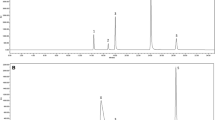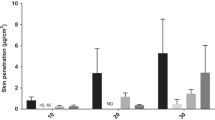Abstract
Dermal exposure is one of the main ways of human body exposure to atmospheric contaminants such as polycyclic aromatic hydrocarbons (PAHs). The skin type significantly affects the skin adsorption of contaminants. However, this is commonly ignored in assessing the dermal exposure based on the atmospheric concentrations of contaminants. In this study, a simulation device suitable for human dermal pollutant exposure assessment was established, which used polyethylene balloons coated with different doses of glycerol trioleate to simulate oily skin, neutral skin, and dry skin type. The sampling effectiveness of the device was verified, and the device was applied to the skin exposure assessment of atmospheric PAHs at different scenarios. Kinetic experiments indicated a linear adsorption within 6 h. The adsorption kinetic constants (k) of PAHs on the oily surface of the balloon were significantly higher than those on the dry surface, especially for PAHs with high ring numbers. Compared with the calculated skin adsorption based on atmospheric concentrations, the results of this simulation device can better simulate the skin adsorption of atmospheric contaminants on different skin types and in different scenarios. Based on the result of balloon sampling, the dermal exposure of PAH3 rings by oily skin inside the tunnel is up to 5.668 ng/cm2/day, indicating a non-negligible health risk.





Similar content being viewed by others
Data availability
We confirm that all data have been supplied in the paper and availability.
References
Ahn K (2014) The role of air pollutants in atopic dermatitis. J Allergy Clin Immunol 134:993–999. https://doi.org/10.1016/j.jaci.2014.09.023
Baumann L (2008) Understanding and treating various skin types: the Baumann skin type indicator. Dermatol Clin 26:359–373. https://doi.org/10.1016/j.det.2008.03.007
Bourgart E, Barbeau D, Marques M, von-Koschembahr A, Beal D, Persoons R, Leccia MT, Douki T, Maitre A (2019) A realistic human skin model to study benzo[a]pyrene cutaneous absorption in order to determine the most relevant biomarker for carcinogenic exposure. Arch Toxicol 93:81–93. https://doi.org/10.1007/s00204-018-2329-2
Cao DD, Lv K, Gao W, Fu J, Wu J, Fu JJ, Wang YW, Jiang GB (2019) Presence and human exposure assessment of organophosphate flame retardants (OPEs) in indoor dust and air in Beijing. China Ecotoxicol Environ Saf 169:383–391. https://doi.org/10.1016/j.ecoenv.2018.11.038
Chen MR, Tsai PJ, Wang YF (2008) Assessing inhalatory and dermal exposures and their resultant health-risks for workers exposed to polycyclic aromatic hydrocarbons (PAHs) contained in oil mists in a fastener manufacturing industry. Environ Int 34:971–975. https://doi.org/10.1016/j.envint.2008.02.008
Chen MQ, Jiang JY, Gan ZW, Yan Y, Ding SL, Su SJ, Bao XM (2019) Grain size distribution and exposure evaluation of organophosphorus and brominated flame retardants in indoor and outdoor dust and PM10 from Chengdu. China J Hazard Mater 365:280–288. https://doi.org/10.1016/j.jhazmat.2018.10.082
China National Health Commission (2020) Report on nutrition and chronic - diseases of Chinese residents. 2020–12–23 (in Chinese). Available from: http://www.gov.cn/. Accessed 18 Jan 2021
Cranor WL, Alvarez DA, Huckins JN, Petty JD (2009) Uptake rate constants and partition coefficients for vapor phase organic chemicals using semipermeable membrane devices (SPMDs). Atmos Environ 43:3211–3219. https://doi.org/10.1016/j.atmosenv.2009.03.043
Fernando S, Shaw L, Shaw D, Gallea M, VandenEnden L, House R, Verma DK, Britz-McKibbin P, McCarry BE (2016) Evaluation of firefighter exposure to wood smoke during training exercises at burn houses. Environ Sci Technol 50:1536–1543. https://doi.org/10.1021/acs.est.5b04752
Gasperi J, Lorgeoux C, Moilleron R, Gromaire MC, Chebbo G (2009) Settling velocity grading of particle bound PAHs: case of wet weather flows within combined sewer systems. J Environ Eng (new York) 135:1155–1160. https://doi.org/10.1061/(ASCE)0733-9372(2009)135:11(1155)
Gracia-Cazana T, Gonzalez S, Parrado C, Juarranz A, Gilaberte Y (2020) Influence of the exposome on skin cancer. Actas Dermosifiliogr 111:460–470. https://doi.org/10.1016/j.ad.2020.04.008
Guo Y, Kannan K (2011) Comparative assessment of human exposure to phthalate esters from house dust in China and the United States. Environ Sci Technol 45:3788–3794. https://doi.org/10.1021/es2002106
Harner T, Farrar NJ, Shoeib M, Jones KC, Gobas FAPC (2003) Characterization of polymer-coated glass as a passive air sampler for persistent organic pollutants. Environ Sci Technol 37:2486–2493. https://doi.org/10.1021/es0209215
He X, Chen S, Quan X, Zhao YZ, Zhao HM (2009) Temperature-dependence of soil/air partition coefficients for selected polycyclic aromatic hydrocarbons and organochlorine pesticides over a temperature range of −30 to +30 degrees C. Chemosphere 76:465–471. https://doi.org/10.1016/j.chemosphere.2009.03.038
Kammer R, Tinnerberg H, Eriksson K (2011) Evaluation of a tape-stripping technique for measuring dermal exposure to pyrene and benzo(a)pyrene. J Environ Monit 13:2165–2171. https://doi.org/10.1039/C1EM10245A
Kampa M, Castanas E (2008) Human health effects of air pollution. Environ Pollut 151:362–367. https://doi.org/10.1016/j.envpol.2007.06.012
Kezic S, Meuling WJA, Jakasa I (2004) Free and total urinary 2-butoxyacetic acid following dermal and inhalation exposure to 2-butoxyethanol in human volunteers. Int Arch Occup Environ Health 77:580–586. https://doi.org/10.1007/s00420-004-0540-3
Khairy MA, Lohmann R (2013) Source apportionment and risk assessment of polycyclic aromatic hydrocarbons in the atmospheric environment of Alexandria. Egypt Chemosphere 91:895–903. https://doi.org/10.1016/j.chemosphere.2013.02.018
Khaiwal R, Ranjeet S, René V, Grieken, (2008) Atmospheric polycyclic aromatic hydrocarbons: source attribution, emission factors and regulation. Atmos Environ 42:2895–2921. https://doi.org/10.1016/j.atmosenv.2007.12.010
Lao JY, Xie SY, Wu CC, Bao LJ, Tao S, Zeng EY (2018) Importance of dermal adsorption of polycyclic aromatic hydrocarbons derived from barbecue fumes. Environ Sci Technol 52:8330–8338. https://doi.org/10.1021/acs.est.8b01689
Lao JY, Wang SQ, Chen YQ, Bao LJ, Lam PKS, Zeng EY (2020) Dermal exposure to particle-bound polycyclic aromatic hydrocarbons from barbecue fume as impacted by physicochemical conditions. Environ Pollut 260:114080. https://doi.org/10.1016/j.envpol.2020.114080
Larsen RK, Baker JE (2003) Source apportionment of polycyclic aromatic hydrocarbons in the urban atmosphere: a comparison of three methods. Environ Sci Technol 37:1873–1881. https://doi.org/10.1021/es0206184
Liu LB, Yan L, Lin JM, Ning T, Hayakawa K, Maeda T (2007) Development of analytical methods for polycyclic aromatic hydrocarbons (PAHs) in airborne particulates: a review. J Environ Sci 19:1–11. https://doi.org/10.1016/S1001-0742(07)60001-1
Liu Y, Gao Y, Yu N, Zhang CK, Wang SY, Ma LM, Zhao JF, Lohmann R (2015) Particulate matter, gaseous and particulate polycyclic aromatic hydrocarbons (PAHs) in an urban traffic tunnel of China: emission from on-road vehicles and gas-particle partitioning. Chemosphere 134:52–59. https://doi.org/10.1016/j.chemosphere.2015.03.065
Lohmann R, Corrigan BP, Howsam M, Jones KC, Ockenden WA (2001) Further developments in the use of semipermeable membrane devices (SPMDs) as passive air samplers for persistent organic pollutants: field application in a spatial survey of PCDD/Fs and PAHs. Environ Sci Technol 35:2576–2582. https://doi.org/10.1021/es0001862
Mancilla Y, Mendoza A (2012) A tunnel study to characterize PM2.5 emissions from gasoline-powered vehicles in Monterrey. Mexico Atmos Environ 59:449–460. https://doi.org/10.1016/j.atmosenv.2012.05.025
Miguel AH, Kirchstetter TW, Harley RA, Hering SV (1998) On-road emissions of particulate polycyclic aromatic hydrocarbons and black carbon from gasoline and diesel vehicles. Environ Sci Technol 32:450–455. https://doi.org/10.1021/es970566w
National standard of China (1999) GBT2428–1998: Head - face dimensions of adult. Beijing, State Administration of quality and technical supervision (in Chinese)
Ning Z, Polidori A, Schauer JJ, Sioutas C (2008) Emission factors of PM species based on freeway measurements and comparison with tunnel and dynamometer studies. Atmos Environ 42:3099–3114. https://doi.org/10.1016/j.atmosenv.2007.12.039
Pappas A (2015) Sebaceous lipids. In: Pappas A (eds) Lipids and skin health. Springer, Cham. https://doi.org/10.1007/978-3-319-09943-9_9
Puri P, Nandar SK, Kathuria S, Ramesh V (2017) Effects of air pollution on the skin: a review. Indian J Dermatol Venereol Leprol 83(4):415–423. https://doi.org/10.4103/0378-6323.199579
Rantakokko P, Kumar E, Braber J, Huang T, Kiviranta H, Cequier E, Thomsen C (2019) Concentrations of brominated and phosphorous flame retardants in Finnish house dust and insights into children’s exposure. Chemosphere 223:99–107. https://doi.org/10.1016/J.CHEMOSPHERE.2019.02.027
Roy D, Breton L, De Vecchi R (2021) Exposome extrinsic factors in the tropics: the need for skin protection beyond solar UV radiation. Sci Total Environ 782:146921. https://doi.org/10.1016/j.scitotenv.2021.146921
Saint-Leger D, Berrebi C, Duboz C, Agache P (1979) The lipometre: an easy tool for rapid quantitation of skin surface lipids (SSL) in man. Arch Dermatol Res 265:79–89. https://doi.org/10.1007/BF00412704
Simonin JP (2016) On the comparison of pseudo-first order and pseudo-second order rate laws in the modeling of adsorption kinetics. Chem Eng J 300:254–263. https://doi.org/10.1016/j.cej.2016.04.079
Strandberg B, Gustafson P, Soderstrom H, Barregard L, Bergqvist PA, Sallsten G (2006) The use of semipermeable determine persistent membrane devices as passive samplers to organic compounds in indoor air. J Environ Monitor 8:257–262. https://doi.org/10.1039/b513120k
Sun KL, Song Y, He FL, Jing MY, Tang JC, Liu RT (2021) A review of human and animals exposure to polycyclic aromatic hydrocarbons: health risk and adverse effects, photo-induced toxicity and regulating effect of microplastics. Sci Total Environ 773:145403. https://doi.org/10.1016/j.scitotenv.2021.145403
Thadanipon K, Kitsongsermthon J (2020) Comparative study into facial sebum level, pore size, and skin hydration between oily-skinned and dry-skinned Thai women. Skin Res Technol 26:163–168. https://doi.org/10.1111/srt.12792
Wang L, Zhang YL, Liu YB, Gong XY, Zhang T, Sun HW (2019) Widespread occurrence of bisphenol A in daily clothes and its high exposure risk in humans. Environ Sci Technol 53:7095–7102. https://doi.org/10.1021/acs.est.9b02090
Wescher CJ, Beko G, Koch HM, Salthammer T, Schripp T, Toftum J, Clausen G (2015) Transdermal uptake of diethyl phthalate and di(n-butyl) phthalate directly from air: experimental verification. Environ Health per 123:928–934. https://doi.org/10.1289/ehp.1409151
Weschler CJ, Nazaroff WW (2008) Semivolatile organic compounds in indoor environments. Atmos Environ 42:9018–9040. https://doi.org/10.1016/j.atmosenv.2008.09.052
Weschler CJ, Nazaroff WW (2012) SVOC exposure indoors: fresh look at dermal pathways. Indoor Air 22:356–377. https://doi.org/10.1111/j.1600-0668.2012.00772.x
Wu Y, Yang L, Zheng X, Zhang SJ, Song SJ, Li JQ, Hao JM (2014) Characterization and source apportionment of particulate PAHs in the roadside environment in Beijing. Sci Total Environ 470:76–83. https://doi.org/10.1016/j.scitotenv.2013.09.066
Wu CC, Bao LJ, Guo Y, Li SM, Zeng EY (2015) Barbecue fumes: an overlooked source of health hazards in outdoor settings? Environ Sci Technol 49:10607–10615. https://doi.org/10.1021/acs.est.5b01494
Wu CC, Bao LJ, Tao S, Salthammer T, Schripp T, Toftum J, Clausen G (2016) Dermal uptake from airborne organics as an important route of human exposure to e-waste combustion fumes. Environ Sci Technol 50:6599–6605. https://doi.org/10.1021/acs.est.5b05952
Zhang LL, Yang L, Zhou QY, Zhang X, Xing WL, Wei YJ, Hu M, Zhao LX, Toriba A, Hayakawa K, Tang N (2020) Size distribution of particulate polycyclic aromatic hydrocarbons in fresh combustion smoke and ambient air: a review. J Environ Sci 88:370–384. https://doi.org/10.1016/j.jes.2019.09.007
Zhao T, Yang LX, Huang Q, Zhang Y, Bie SJ, Li JS, Zhang W, Duan SF, Gao HL, Wang WX (2020) PM2.5-bound polycyclic aromatic hydrocarbons (PAHs) and their derivatives (nitrated-PAHs and oxygenated-PAHs) in a road tunnel located in Qingdao, China: characteristics, sources and emission factors. Sci Total Environ. 720:137521. https://doi.org/10.1016/j.scitotenv.2020.137521
Zheng YM, Liang HY, Zhou MY, Song LY, He CF (2021) Skin bacterial structure of young females in China: the relationship between skin bacterial structure and facial skin types. Exp Dermatol 30:1366–1374. https://doi.org/10.1111/exd.14105
Zhu XH, Pfister G, Henkelmann B, Kotalik J, Bernhoft S, Fiedler S, Schramm KW (2008) Simultaneous monitoring of profiles of polycyclic aromatic hydrocarbons in contaminated air with semipermeable membrane devices and spruce needles. Environ Pollut 156:461–466. https://doi.org/10.1016/j.envpol.2008.01.023
Funding
This work was supported by the National Natural Science Foundation of China (41722304). The study was funded in part by the Tianjin Municipal Science and Technology Bureau (18JCJQJC47100) and the Ministry of Education, China (T2017002).
Author information
Authors and Affiliations
Contributions
Xinxin Li: data curation, formal analysis, investigation, software, visualization, writing—original draft.
Yinzuo Liu: data curation.
Ting Wang: methodology, supervision, writing—review and editing.
Lei Wang: conceptualization, methodology, funding acquisition, supervision, writing—review and editing.
Corresponding author
Ethics declarations
Ethics approval
The study did not involve any human and animal experiments requiring ethical approval.
Consent to participate and consent to publish
We confirm that all authors of the paper consent to participate and consent to publish.
Competing interests
The authors declare no competing interests.
Additional information
Responsible Editor: Lotfi Aleya
Publisher's note
Springer Nature remains neutral with regard to jurisdictional claims in published maps and institutional affiliations.
Supplementary Information
Below is the link to the electronic supplementary material.
Rights and permissions
About this article
Cite this article
Li, X., Liu, Y., Wang, T. et al. A simple device for simulating skin adsorption of polycyclic aromatic hydrocarbons: design and application. Environ Sci Pollut Res 29, 71208–71216 (2022). https://doi.org/10.1007/s11356-022-20851-5
Received:
Accepted:
Published:
Issue Date:
DOI: https://doi.org/10.1007/s11356-022-20851-5




